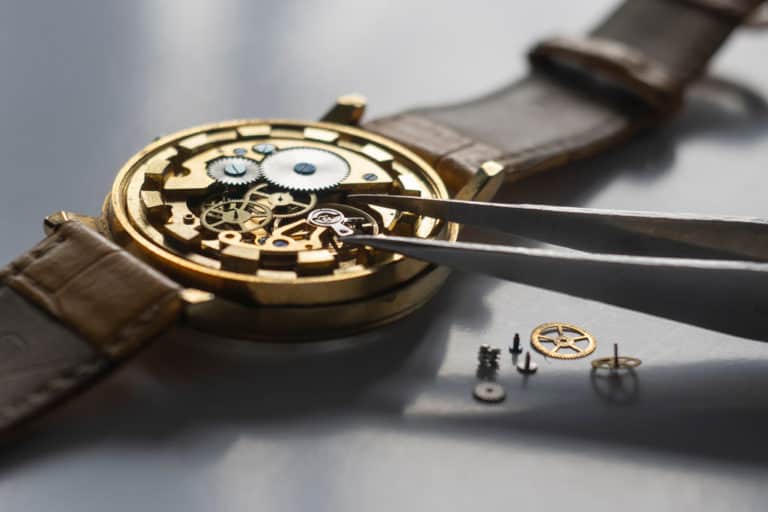Have you ever taken in the wonder of a glow-in-the-dark watch? It has the power to captivate your attention, but historically, these watches have come at a cost to human life and safety. Thankfully, the use of radium has stopped altogether, but what replaced this radioactive substance?
Although glow-in-the-dark watches used radium before, it was carcinogenic and caused many deaths by radium necrosis, also known as radium jaw. Radium was eventually banned in 1968, and watches instead used tritium and promethium initially and now mostly LumiNova, among others.
Although you might think of glow-in-the-dark watches as a novelty, they have a dark and checkered past. Watchmakers are no longer allowed to use radium because of the danger it poses to them. If you want to know how luminescent watches are produced nowadays, read on!
History Of Radium Use
Radium, discovered in 1898 by Nobel laureate Marie Curie and her husband Pierre, was used initially as a health tonic and became the new craze. Radium water was seen as a way to revitalize yourself if you suffered maladies seen to be caused by energy deficiencies like fatigue and impotence.
Radium was added to everything from makeup to chocolate to toothpaste. Radium spas and clinics popped up, and radium was even used for cancer treatments. The word “radium” was even used to market products that had nothing to do with it.
Radium Use In Watches
The United States Radium Corporation operated between 1917 and 1926 in New Jersey. They produced a glow-in-the-dark paint called “UnDark,” using radium as the primary ingredient. This paint was used to create luminescent watches that didn’t require charging to shine in the dark.
The watches were all the rage, even used by the military in World War I. Radium was also used to paint the dials and gauges of airplanes so that pilots could fly at night without cockpit lights and avoid being seen by enemy combatants.
The women who painted the dials not only felt that they were helping the war effort, but they also made good money. However, they were instructed to wet the tips of the paintbrush with their lips to maintain a fine point, unknowingly ingesting a highly radioactive and carcinogenic substance.
This led to radium necrosis or radium jaw, a condition where a person’s jawbone would degenerate to the point where the dial painters would die. In 1922, these luminescent watches took their first victim.
At age 22, Mollie Maggia died after suffering for more than a year. Her cause of death was reported as syphilis, while the true cause was radium necrosis. In fact, her lower jawbone could be easily removed by hand as it had become so brittle.
Five years later, Grace Fryer and four other fellow dial painters, known as the Radium Girls, filed a case against the United States Radium Corporation, and, in 1928, they won against the company. The survivors were recompensed, and death certificates revised.
This saga was encapsulated by the 2018 drama film Radium Girls, which stars Joey King. Radium was phased out in the face of several lawsuits against the US Radium Corporation.
By the 1960s, radium use had decreased to around one-hundredth of the amount used in the early 1900s. The last radium watches were produced in 1968 when it was banned.
Although radium watches are more dangerous to their makers than to their wearers, the slow and agonizing deaths of the dial painters cannot be overlooked when considering whether alternatives should be used.
What Glow-In-The-Dark Watches Use Now
Mercifully, technology has evolved to a point where glow-in-the-dark watches are much safer to make and use. There are several alternatives to radium, which should be used even if they don’t produce as brilliant results as radium.
Tritium And Promethium
Radium was initially replaced by tritium, which is also radioactive and operates similarly to radium. However, tritium is decidedly less radioactive than radium, making it a safer alternative.
The half-life of radium is 1602 years, meaning it takes many lifetimes to decay and become less luminous. Tritium has a half-life of 12.32 years. Another radium alternative, promethium, has a half-life of 2.62 years, but tritium is preferred as it shines for longer.
LumiNova And Super-LumiNova
This was later replaced by photoluminescent material like strontium aluminate. This material is what is most used in glow-in-the-dark watches nowadays.
LumiNova was invented by Japanese company Nemoto & Co. in 1993. Five years later, Nemoto and RC-Tritec AG joined efforts to form LumiNova AG Switzerland. LumiNova works like a “light bank.” It stores the light it is exposed to and will shine brightly for the first few hours after light exposure.
The major downside to using LumiNova and Super-LumiNova is that it doesn’t glow throughout the night as radium watches did. But, this hardly seems like a hefty price to pay for avoiding radium necrosis and radium-contaminated buildings.
Super-LumiNova refers to LumiNova produced solely in Switzerland and is available in 3000 colors with different levels of brightness and varying shades.
Tritium Gas Tubes
Although LumiNova dominates the market, there is some interest in tritium gas tubes. These tubes are made out of borosilicate glass, and because they are contained in the tubes, they are less hazardous than tritium paint.
The tubes, unlike LumiNova, glow all through the night. However, they need replacement after a while since they will become duller each year.
LumiBrite
Another photoluminescent paint available is LumiBrite. The difference between it and LumiNova is that it uses europium and dysprosium to increase its effectiveness in emitting light. Watches made using this technology would shine for 3-5 hours in the dark after only 10 minutes of light exposure.
Electroluminescence
A further alternative to radium is electroluminescence. This is produced by an electrical current reacting with phosphor, creating a backlight. Although most common in digital watches, analog watches like Timex’s Indiglo use electroluminescence, as patented by them in 1992.

Conclusion
Glow-in-the-dark dials are useful, especially in the military, where using a brighter light to navigate safely would cause enemy combatants to spot one’s location. However, using radium to create these watches is dangerous and can lead to many deaths.
Thankfully, many alternative substances and technologies can replace the use of radium. The most prominent among these is LumiNova. So, glow-in-the-dark watches don’t use radium, but they still shine brightly!
Resources
- https://www.theatlantic.com/health/archive/2013/03/how-we-realized-putting-radium-in-everything-was-not-the-answer/273780/
- https://edition.cnn.com/style/article/radium-girls-radioactive-paint/index.html
- https://www.gearpatrol.com/watches/a324890/watch-lume/
- https://www.epa.gov/radtown/radioactivity-antiques
- https://www.bloomberg.com/news/articles/2018-07-09/what-makes-luminous-watch-dials-glow-a-brief-history-of-shine
- https://www.chemeurope.com/en/encyclopedia/United_States_Radium_Corporation.html
- https://www.prestigetime.com/blog/watch-luminescence.html







